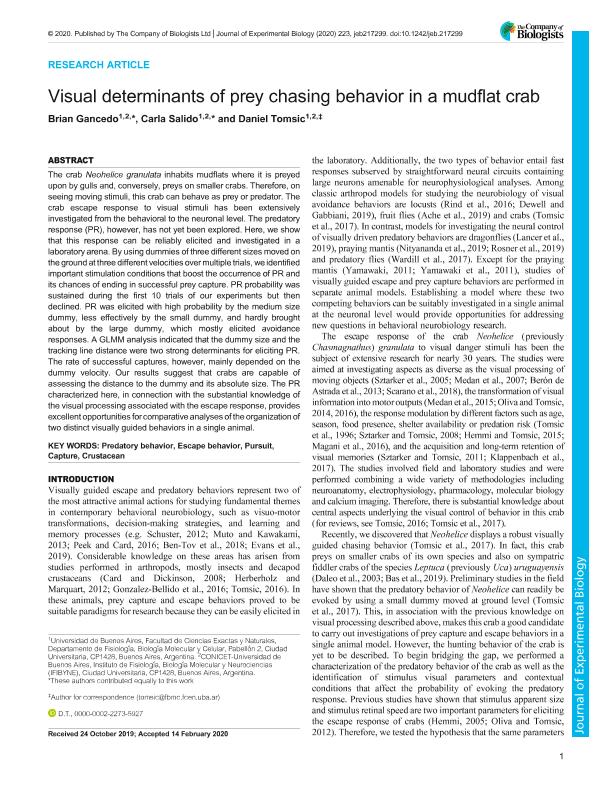Artículo
Visual determinants of prey chasing behavior in a mudflat crab
Fecha de publicación:
03/2020
Editorial:
Company of Biologists
Revista:
Journal of Experimental Biology
ISSN:
0022-0949
Idioma:
Inglés
Tipo de recurso:
Artículo publicado
Clasificación temática:
Resumen
The crab Neohelice granulata inhabits mudflats where it is preyed upon by gulls and, conversely, preys on smaller crabs. Therefore, on seeing moving stimuli, this crab can behave as prey or predator. The crab escape response to visual stimuli has been extensively investigated from the behavioral to the neuronal level. The predatory response (PR), however, has not yet been explored. Here, we show that this response can be reliably elicited and investigated in a laboratory arena. By using dummies of three different sizes moved on the ground at three different velocities over multiple trials, we identified important stimulation conditions that boost the occurrence of PR and its chances of ending in successful prey capture. PR probability was sustained during the first 10 trials of our experiments but then declined. PR was elicited with high probability by the medium size dummy, less effectively by the small dummy, and hardly brought about by the large dummy, which mostly elicited avoidance responses. A GLMM analysis indicated that the dummy size and the tracking line distance were two strong determinants for eliciting PR. The rate of successful captures, however, mainly depended on the dummy velocity. Our results suggest that crabs are capable of assessing the distance to the dummy and its absolute size. The PR characterized here, in connection with the substantial knowledge of the visual processing associated with the escape response, provides excellent opportunities for comparative analyses of the organization of two distinct visually guided behaviors in a single animal.
Palabras clave:
Comportamiento presa predador
,
Visión
,
Crustaceos
,
Insectos
Archivos asociados
Licencia
Identificadores
Colecciones
Articulos(IFIBYNE)
Articulos de INST.DE FISIOL., BIOL.MOLECULAR Y NEUROCIENCIAS
Articulos de INST.DE FISIOL., BIOL.MOLECULAR Y NEUROCIENCIAS
Citación
Gancedo, Brian Julian; Salido, Carla Adriana; Tomsic, Daniel; Visual determinants of prey chasing behavior in a mudflat crab; Company of Biologists; Journal of Experimental Biology; 223; 6; 3-2020; 1-11
Compartir
Altmétricas




